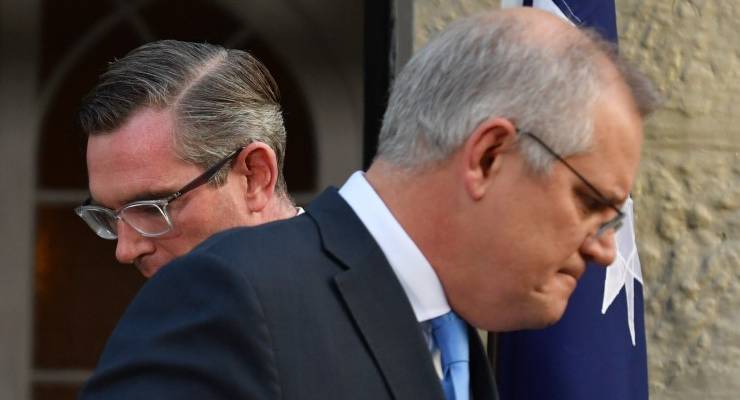
After a painfully embarrassing week abroad, Prime Minister Scott Morrison is back in the country and straight into election mode. After touching down in Sydney last night, the prime minister is planning a week-long post-COVID blitz through New South Wales and Victoria.
It’s an opportunity for Morrison, whose trustworthiness has come under assault this week, to rebuild voters’confidence ahead of an election likely to be held in March or May. And the pit stops he makes on the road will give us a clear idea of where and how the Liberals are hoping to win.
First up is Sydney, where Morrison held a press conference with NSW Premier Dominic Perrottet at the WestConnex motorway this morning. The prime minister will be hoping to cash in on any goodwill towards the state Liberal government over the reopening. So far, the federal government has borne the brunt of the baggage for long lockdowns, and Morrison has struggled to take credit for things the way his state counterparts have.
The Liberals have also maintained NSW is key to their reelection chances, and are targeting up to 10 Labor-held seats there. Labor, meanwhile, is on the defensive in the state, and some in the party are lukewarm about their chances of making gains in suburban Sydney.
Morrison is expected to make a play at Hunter Valley coal country, where Labor holds seats the Coalition believes could be vulnerable. High on that list is Hunter, once safe for Labor, but where long-term MP Joel Fitzgibbon, who copped a large swing against him in 2019, is retiring. It’s hoped the Coalition’s support for mining, and enduring perceptions of Labor’s hostility to an industry that once made up its base, will put it and Shortland and Paterson in play. Elsewhere in the state are some of Labor’s most marginal seats, including Macquarie (0.2%), Eden-Monaro (0.8%), Dobell (1.5%) and Gilmore (2.6%).
Morrison’s NSW roadshow may encounter two problems. First, preselections haven’t been finalised for key seats like Dobell and Gilmore, reportedly because Morrison’s key factional ally, Immigration Minister Alex Hawke, is stalling in order to get his preferred candidates in. In Hunter seats, there’s some tension within the Coalition over whether the Nationals should run.
But Morrison’s bigger problem right now is the polls — they all have Labor comfortably ahead on a two-party-preferred basis. Roy Morgan’s most recent NSW state-based poll, conducted after former premier Gladys Berejiklian resigned in scandal, showed Labor up to 55.5%-45.5% over the Coalition, a swing of 7% since the last election.
In Victoria, Roy Morgan shows Labor looking even stronger, at 56.5% to 43.5%.
It’s been months since Morrison was in Victoria, where he must grapple with a perception, boosted hard by Labor, that he’s the “prime minister for NSW.” Again, the key issue, particularly in Melbourne, the world’s most locked-down city, is which party will be able to capitalise on the reopening.
While perceptions of the Morrison government’s indifference to Melbourne and pro-Sydney bias are an article of faith to some Labor MPs and progressives on social media, it’s unclear how widely held a view that is in the electorate. And despite strong polling in the state giving the impression of a potential Labor bloodbath in Melbourne, the party is cautiously pessimistic about its chances, pointing to Chisholm as its only real expected gain so far.
Part of that pessimism is a natural hangover from the shock of 2019. It’s also a recognition of how far there is to go before the election.
Morrison has spent his last few weeks away from voters, grappling with the Nationals during a parliamentary sitting fortnight or getting ripped to shreds by foreign leaders. But it’s on the campaign trail where he’s at his best. No surprise that he’s decided it’s to dust off the baseball cap and the cringey daggy-dad schtick and hit the road.








The LNP have established a trend in government since 2013. Lying, incompetence, abuse of power, infighting and arrogance have been their defining characteristics and they’ve refined all of them to the stage of running the most brutally incompetent and corrupt administration in our history. It’s not so much the LNP has lost its principles. It doesn’t understand the word. Surely their luck has to run out soon.
Alas, their luck won’t run out while they have the backing of the [evil] murdoch empire and tacit support from the Nine papers..
Most free-to-air TV channels go easy with LNP coalition interviews. Labor bashing now also common. MSM know where their bread and butter comes from and acts accordingly.
You are so correct, Aged female, and the situation disgusts me.
You can add the ABC to that line-up…yesterday The Drum and Q&A, in particular, were appalling. NO Labor representatives, and a free-for-all from some of the participants tipping a bucket on Labor, without any come-back from the moderators. Looks like it will be a long hard road for Labor from here to the election.
The ABC is a disgrace!!
The ABC is prioritising it’s funding now.
They know on which side their bread is buttered.
The ABC has butter?
I didn’t know that. Remove that privilege………..and take the bread away as well.
It’s the rancid variety.
For ‘Tast tango in Paris’ purposes.
oops, Last Tango.
Gone from anodyne to biased; panel shows are appalling and made for set ups and/or loading with LNP related, even unashamedly using professional PR types (because they know how to operate on tv well on any topic vs. MPs or unions reps?).
Like The Drum, Q&A is hardly a forum to be informed and it’s inspiration i.e. BBC’s Question Time did not pretend to be neutral when their ‘Audience Producer’ was inviting far right and/or anti-immigrant peeps on; after complaints of ongoing audience bias on ‘wedge’ issues of immigration, Brexit etc..
I’ve never watched Q&A as it’s so obviously formulated in order to grab the motivated angry…….in order to manufacture another headline.
FTA (beyond the AFL grand final) is something I don’t waste my time on anymore………but then I am a bit old, bitter and twisted.
Long ago I gave up on Q&A and The Insiders.
They have been turned into organs of LNP/IPA propaganda and not even very good organs, either. David Speers makes Uriah Heep seem attractive.
Don’t forget Clive’s millions
Not if Murdoch backs him……..and Albo releases progressive policies for Rupert’s delectation.
“… Morrison, whose trustworthiness has come under assault this week …”
Surely it must be plain to all that Mr. Morrison’s trustworthiness simply does not exist? He is that rarest of creatures, a man totally without moral fibre or a sense of personal honour.
A lesson in how inattentive Australian voters are that this lying, incompetent, corrupt and secretive joke of a PM is given any chance in the next election.
Will Morrison be stopping to meet and greet the locals in Cobargo?
Did you mean ‘meet & grab’?
YEP just like his creepy mate Dr Lamming.
Would Mr. Morrison (I am always respectful) have the courage to meet and greet the locals in Cobargo?
As Bill Hayden said in ‘83 – even a drover’s dog would beat this lot…..or words to that effect.
Well, Labour’s certainly got the drover’s dog for the job of rounding up the sheep………if they notice him.
Trouble is that he is afraid of being savaged by those sheep, even as they head over the cliff with Scummo.
Hitting the road to garner votes. Hmmmm does this mean he will approach disgruntled people with a hand shake and a slap on the back. He may as well tell everyone who sees him in the true light shining down from heaven “to get over it”. By doing so he will alienate more. Scotty has been backed into a corner by his own rhetoric and GOD will not save him… He might hope for the kiss of life from rollover Frydenberg but that will only give a chance to be rushed to intensive care where he may summon up the courage to admit his failings. May he rest in peace.
And, these guys love a small government and no red tape. Let Australia be bought out by multi nationals and foreigners so the ELITE can rake in dollars is THERE MANTRA. Screw the LNP
Its Labor….FFS!!!
I’m not Irish American sonny.
No idea of your nationality, sonny, but it is the Labor party…been that way since 1912
The labour movement opted for Labor not because of King O’Malley’s ethnicity (Ireland has a Labour party) nor his place of birth.
It was in line with the then progressive movement to rationalise English orthography – see George Bernard Shaw’s advocacy of ghoti (fish).
Labour (pregnancy) vs Labor (to toll, work hard)
Whatever Americans use I don’t use.
You mentioned amerikan – nobody else.
Why are some so sensitive about Labour rather than Labor……..is it that much of a problem for you ?
Another poster mentioned that – I merely pointed out how Labor came to have that spelling.